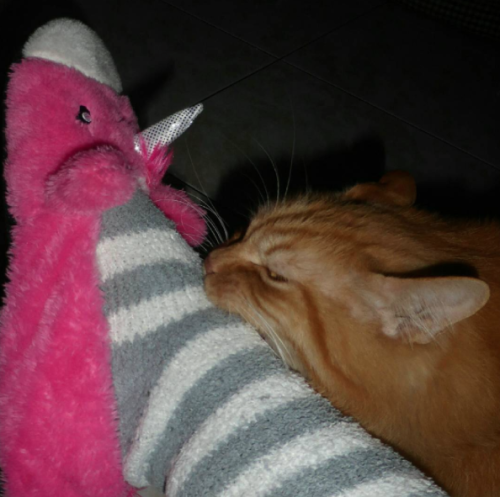Rocks-everywhere - Science, Plants, Cats, Music, And More










More Posts from Rocks-everywhere and Others

A Highland Coo and her calf wandering down an empty road, Argyll and the Isles, Scotland. Credit: Andy Maclachlan.

Imagine your mum being so terrified of you becoming a poet like your dad that you accidentally become the world’s first computer programmer instead










happy palentines day, geology edition
bonus

paleontology ones
quintner
Hi, it’s been a while 👋🏻😊 My first-ever ‚pool walk video‘ to a nice golden morning view of Mt Pilatus, watch until the end🏔☀️. Got up really early but it was worth doing.
hobopeeba
Hutt Lagoon is a pink lake on the West Coast near the town of Gregory. This very small town is located on a narrow spit between the ocean and the pink lagoon.
Hutt Lagoon is a pink lake, a salt lake with a red or pink hue due to the presence of the carotenoid-producing algae Dunaliella salina, a source of ß-carotene, a food-colouring agent and source of vitamin A.
I dreamed about the pink lake for a long time, and it turned out to be better than my dreams. Pools with a different shade of red, pink, and sometimes yellow and blue. Pink salt on the shore, which glitters like snow - it all looks like abstractionist paintings in reality. Nature and man in this case did the magic.

The importance of a good and matching teacher or supervisor. You see, even birds can struggle with an inconvenient teaching style.
“It might be imagined that the most brilliant birds would be able to learn at any tempo, whereas others would learn well only when tutored at a slow tempo. But Mets and Brainards’ results demonstrate that this is not the case. Most remarkably, birds that were genetically tuned to sing slowly were not inherently worse learners. In fact, they often learnt better than the fast birds once the tutoring tempo ‘resonated’ with them.“
From the article: Tchernichovski and Conley. A genetically tailored education for birds, Nature 2019, 575. https://www.nature.com/articles/d41586-019-03416-4
When Dwarfs Meet Giants, and Other True Cosmic Fairy Tales
It’s easy to get lost in fantasy worlds through science-fiction movies and novels, but did you know that some of your favorite fairy tale characters actually exist in cosmic form? From dwarfs and giants to shape-shifters and buried treasure, the universe is home to a multitude of mystical objects.
White Dwarf Stars

You’ve probably heard of dwarfs like Happy and Sneezy (or Gimli and Thorin), but it’s unlikely you’re familiar with the space-dwelling dwarfs with names like Sirius B and ASASSN-16oh. White dwarf stars like these are typically about the size of Earth, which is pretty small as far as stars go. They represent one of three final stages of stellar evolution, along with neutron stars and black holes. Each star’s mass determines which one it will ultimately become. Stars much more massive than the Sun typically become neutron stars or black holes, and lower-mass stars end up as white dwarfs.

Our Sun will eventually become a white dwarf after it exhausts its fuel, but don’t worry — we’ve got several billion years to go! Before it is reduced to a white dwarf it will actually expand into a red giant, swelling out to encompass Earth’s orbit. But we don’t have to wait billions of years to see stellar giants … some already peek out at us from the cosmic deep.
Giants and Supergiants

The red giant star Aldebaran, located about 65 light-years away, is about 5,000 times bigger than Earth. Our Cassini spacecraft imaged Aldebaran through Saturn’s rings in 2006, but you can see it for yourself during northern winter. Just look for the brightest star in the constellation Taurus.

Fairy tale giants may be taller than trees, but these supergiant stars can be over 100,000 times “taller” than our entire planet! Supergiant stars are likely becoming more rare as time goes on. While scientists believe they used to be more common, our whole galaxy now contains just a small smattering of supergiants.

These massive stars grace the galaxy for a relatively small amount of time. They burn through their fuel extremely quickly — in just a few million years, as opposed to hundreds of billions of years for the smallest stars! Supergiants often end their lives in dramatic explosions called supernovae.

Betelgeuse — the bright, reddish star marking the shoulder of Orion — is nearing the end of its life and has expanded to become a red supergiant star. It is destined to explode as a supernova, which might happen tonight … or within the next few hundred thousand years.
Ghostly Solar Neutrinos

Even an average star like our Sun has some seemingly magical qualities. Each second, it sends billions of phantom-like neutrino particles out into space. They travel almost as fast as light and don’t usually interact with normal matter. Billions of them are zipping harmlessly straight through your body while you read this. Even at night they go through the entire Earth before reaching you!

But that’s not all … these ghostly particles are shape-shifters, too! Neutrinos can change characteristics over time, morphing between different versions of themselves. Spooky!
Buried Treasure in the Heart of the Galaxy

Extensive clouds of dust enshroud the heart of our Milky Way galaxy, hiding it from our view — at least when it comes to visible light. The dust isn’t as big a problem for infrared light, however, which has allowed us to get a glimpse of our galaxy’s chaotic core thanks to our Hubble and Spitzer space telescopes.

Future missions may peer into the galactic core in search of buried treasure — thousands of planets orbiting distant stars!
Want to learn about more cosmic objects? Find them here!
Make sure to follow us on Tumblr for your regular dose of space: http://nasa.tumblr.com
Love me some rocks

what was the name of the fish my geology teacher called “bad dude” because i put bad dude in my notes and have no idea what the real name is
-
 milady-elessar liked this · 1 month ago
milady-elessar liked this · 1 month ago -
 zzzestyy reblogged this · 1 month ago
zzzestyy reblogged this · 1 month ago -
 ravenh37 liked this · 2 months ago
ravenh37 liked this · 2 months ago -
 toadallytadpole liked this · 2 months ago
toadallytadpole liked this · 2 months ago -
 jesterpanic reblogged this · 2 months ago
jesterpanic reblogged this · 2 months ago -
 tokyocelest liked this · 3 months ago
tokyocelest liked this · 3 months ago -
 swordsparkling liked this · 4 months ago
swordsparkling liked this · 4 months ago -
 amy-dreemurr liked this · 5 months ago
amy-dreemurr liked this · 5 months ago -
 the-golden-heart liked this · 5 months ago
the-golden-heart liked this · 5 months ago -
 lovelyroseghost liked this · 5 months ago
lovelyroseghost liked this · 5 months ago -
 toonsforkicks22 reblogged this · 5 months ago
toonsforkicks22 reblogged this · 5 months ago -
 annaoxdr7 liked this · 6 months ago
annaoxdr7 liked this · 6 months ago -
 entiregoodberryspellbook reblogged this · 6 months ago
entiregoodberryspellbook reblogged this · 6 months ago -
 trishfishseven liked this · 7 months ago
trishfishseven liked this · 7 months ago -
 txuyas reblogged this · 7 months ago
txuyas reblogged this · 7 months ago -
 xsebw liked this · 9 months ago
xsebw liked this · 9 months ago -
 dictatoroffandoms reblogged this · 9 months ago
dictatoroffandoms reblogged this · 9 months ago -
 themindofkaren reblogged this · 10 months ago
themindofkaren reblogged this · 10 months ago -
 waterproofnugget reblogged this · 11 months ago
waterproofnugget reblogged this · 11 months ago -
 cookiepwee liked this · 1 year ago
cookiepwee liked this · 1 year ago -
 trufflesmushroom liked this · 1 year ago
trufflesmushroom liked this · 1 year ago -
 shotofstress reblogged this · 1 year ago
shotofstress reblogged this · 1 year ago -
 loxwyr liked this · 1 year ago
loxwyr liked this · 1 year ago -
 oogika reblogged this · 1 year ago
oogika reblogged this · 1 year ago -
 oogika liked this · 1 year ago
oogika liked this · 1 year ago -
 stupid-shithead reblogged this · 1 year ago
stupid-shithead reblogged this · 1 year ago -
 sneesnoop reblogged this · 1 year ago
sneesnoop reblogged this · 1 year ago -
 inthemorningintomsdiner reblogged this · 1 year ago
inthemorningintomsdiner reblogged this · 1 year ago -
 venidel liked this · 1 year ago
venidel liked this · 1 year ago -
 kristofkristof liked this · 1 year ago
kristofkristof liked this · 1 year ago -
 arrowarcher liked this · 1 year ago
arrowarcher liked this · 1 year ago -
 just-vanya reblogged this · 1 year ago
just-vanya reblogged this · 1 year ago -
 rabid-zombie liked this · 1 year ago
rabid-zombie liked this · 1 year ago -
 lollipopjewel reblogged this · 1 year ago
lollipopjewel reblogged this · 1 year ago -
 skaluli reblogged this · 1 year ago
skaluli reblogged this · 1 year ago -
 skaluli liked this · 1 year ago
skaluli liked this · 1 year ago -
 toratoryuu liked this · 1 year ago
toratoryuu liked this · 1 year ago -
 thecatstolemypen reblogged this · 1 year ago
thecatstolemypen reblogged this · 1 year ago -
 gerardwayebalfro liked this · 1 year ago
gerardwayebalfro liked this · 1 year ago -
 thecatstolemypen liked this · 1 year ago
thecatstolemypen liked this · 1 year ago -
 bisexualbaker liked this · 1 year ago
bisexualbaker liked this · 1 year ago -
 bricky-b liked this · 1 year ago
bricky-b liked this · 1 year ago -
 volumina-vetustiora liked this · 1 year ago
volumina-vetustiora liked this · 1 year ago -
 starstreaker2 liked this · 1 year ago
starstreaker2 liked this · 1 year ago -
 redsixwing reblogged this · 1 year ago
redsixwing reblogged this · 1 year ago -
 lillithdv8 liked this · 1 year ago
lillithdv8 liked this · 1 year ago
225 posts